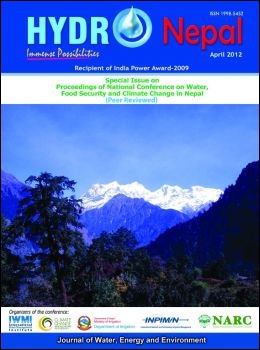Revitalizing Irrigation Systems for Food Security: Vision and Approaches in Nepal Irrigation Systems
DOI:
https://doi.org/10.3126/hn.v11i1.7203Keywords:
Revitalization, infrastructure improvement, agriculture productivity, governance modes, irrigated land loss, NepalAbstract
By 2050, Asia will have to face the challenge of feeding 1.5 billion extra populations. Similarly, the population of Nepal, 26 million in 2011, will also be double by 2050. Food demand will be increasing corresponding to the increase of the population. Nepal’s irrigation sector must first be revitalized to unlock its potential by introducing innovative practices and changing the ways it is governed and managed. Irrigated agriculture holds great potentiality to meet the development challenges and key to increased agriculture production to feed the growing population of Nepal. Besides, increasing the agriculture production, irrigation helps promote Green Revolution, contributes for poverty alleviation, and helps promote rural growth, and food security among people. Dilapidated irrigation systems affects on all these fronts of development issues. It is, therefore, necessary to revitalize the irrigation sector to feed growing population, to ensure livelihood and poverty alleviation and maximize the benefit of available natural resources like water to get more production from limited land availability.
Hence, the revitalizing irrigation systems to meet the food demands of the future are to be considered in an integrated manner consisting infrastructure rehabilitation, investment to raise yield productivity from irrigated land and promotion of appropriate institutions and innovative management modes. There are different agencies that influence the policy and implementation of irrigation sector of Nepal. The central agency is necessary for planning, investment, monitoring, and evaluation of the sector in the larger context. At present, one feels the absence of such central agency which overlooks the overall irrigation sector in compassing all sizes and types and technologies as the national resources.
Pigs are neglected domestic animal species reared under poor care and management. Chwanche, Hurra and Bampudke are major native pigs of Nepal whereas Landrace, Yarkshire, Pakhribash Black, Tamworth and Durock are the introduced pigs. A survey was conducted in selected districts of Nepal in order to understand feeding system of indigenous pigs and also collect feed samples for chemical analysis. In all surveyed sites, the pig herd size was relatively small (2-4/farm). Kitchen waste from home or hotel, local seasonal vegetable or fruit i.e. non-consumable for human being, local sweet potato and their vines (in few areas), roots and tubers and their leaves such as- Pindalu (Clocasea sps), Sweet potato (Ipomoea batatus L), Turnip (Brassia rape) and Radish (Raphnes sativa L), rice bran and maize fl our were the major feed ingredients. Sweet potato had high energy content as compared to other roots and tubers and was comparable to rice bran and maize which are the major sources of energy in livestock feeds. Findings thus indicated that roots and tubers in rural areas could be an alternative as of energy rich feed ingredients which could be utilized if maize and rice bran are expensive and unavailable. Further research on level of feeding, conservation technique and varietals improvement is needed.
DOI: http://dx.doi.org/10.3126/hn.v11i1.7202
Hydro Nepal Special Issue: Conference Proceedings 2012 pp.42-43
Downloads
Downloads
Published
How to Cite
Issue
Section
License
The copyright of the articles and papers published is held by HYDRO Nepal Journal.
The views and interpretation in this journal are those of author(s), and HYDRO Nepal does not bear any responsibility for the views expressed by authors in the journal.




